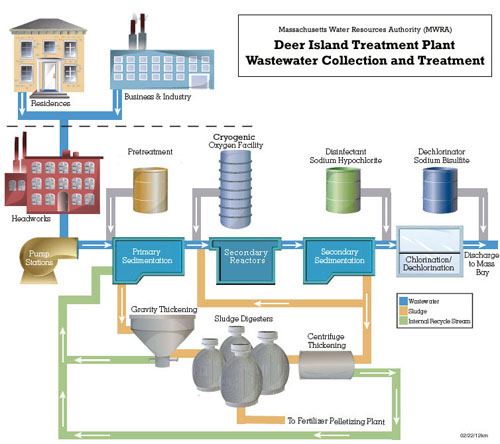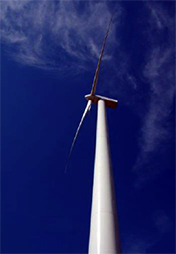| Home |
| About MWRA |
| Water System |
| Sewer System |
| Harbor and Bay |
| School Program |
| Doing Business with MWRA |
| Contact MWRA |
The Deer Island Wastewater Treatment Plant
Massachusetts Water Resources Authority
|
MWRA's Deer Island Wastewater Treatment Plant is the centerpiece of MWRA' $3.8 billion program to protect Boston Harbor against pollution from Metropolitan Boston's sewer systems.
The plant removes human, household, business and industrial pollutants from wastewater that originates in homes and businesses in 43 greater Boston communities. In compliance with all federal and state environmental standards and subject to the precedent-setting discharge permit issued for the plant by EPA and DEP, its treated wastewater can be released to the marine environment.
MAJOR COMPONENTS OF THE PLANT
Pumping
Wastewater "influent" from MWRA customer communities arrives at the plant through four underground tunnels. Pumps then lift the influent about 150 feet to the head of the plant. There are three main pump stations. The North System is served by the North Main Pump Station and the Winthrop Terminal Headworks, containing ten 3,500 hp pumps and six 600 hp pumps. The capacity for the North System is 910 mgd. The Lydia Goodhue Pump Station for the South System can handle an additional 360 mgd of flow, and contains eight 1,250 hp pumps. The pumping capacity at the new Deer Island plant has dramatically increased the volume of wastewater that can be taken into the plant from the conveyance tunnels. This reduces back-ups and overflows throughout the system when wet weather causes peaking of system flows.
Primary Treatment
After pumping, flows pass through grit chambers that remove grit for disposal in an off-island landfill. Next, flows are routed to primary treatment clarifiers that remove about half of the pollutants brought to the plant in typical wastewater (50-60% of total suspended solids and up to 50% of pathogens and toxic contaminants are removed). In this step, gravity separates sludge and scum from the wastewater. The plant uses 48 primary clarifiers that are 186 feet long by 41 feet wide by 24 feet deep. The clarifiers have a "stacked" settling surface at mid-depth to double the settling capacity of the tanks that are squeezed into the tight space confines of Deer Island.
Secondary Treatment
Secondary treatment mixers, reactors and clarifiers remove non-settleable solids through biological and gravity treatment. The biological process is a pure oxygen-activated sludge system, using microorganisms to consume organic matter that remains in the wastewater flow. Secondary treatment raises the level of pollution removal to over 85%.
Three "batteries" of secondary treatment were completed in 1997, 1998 and 2001, respectively. Over one hundred tons of pure oxygen are manufactured each day at Deer Island's cryogenic facility to support the biological treatment process. The Deer Island Treatment Plant generates 130 - 220 tons of pure oxygen per day to support the secondary treatment process.
Sludge Digestion
Sludge and scum from primary treatment are thickened in gravity thickeners. Sludge and scum from secondary treatment are thickened in centrifuges. Polymer is added in the secondary thickening process to increase its efficiency. Digestion then occurs in 12 distinctive egg-shaped anaerobic digesters, each 90 feet in diameter and approximately 130 feet tall. Mimicking the stomach's natural digestion process, microorganisms naturally present in the sludge work to break sludge and scum down into methane gas, carbon dioxide, solid organic byproducts, and water. Digestion significantly reduces sludge quantity. The byproduct of the digestion process is 70 percent methane gas, which is captured and piped to boilers that generate enough heat to warm the buildings on the site as well as for the heat-dependent treatment processes. The steam from those boilers is sent through a steam turbine generator (STG) producing an average of approximately 3 megawatts of electricity. Digested sludge leaves Deer Island is transported through the Inter-Island Tunnel to MWRA's pelletizing facility at Fore River, where it is further processed into a fertilizer product.
Odor Control
Air scrubbers and carbon adsorbers remove odors and volatile organic compounds from treatment process "off-gases". Odor control is used for primary and secondary treatment process facilities, as well as the sludge processing, plant pumping, and grit removal facilities. Odor control performance is constantly monitored and is governed by a special DEP air quality permit.
Disinfection
After passing through primary and secondary treatment, wastewater is disinfected with sodium hypochlorite to kill bacteria. There are two disinfection basins, each approximately 500 feet long with a capacity of 4 million gallons, in which the effluent is mixed with sodium hypochlorite. Finally, sodium bisulfite is added to dechlorinate the water, so that chlorine levels in the ultimate discharge will not threaten marine organisms. After disinfection and dechlorination, the effluent is ready to be discharged.
Effluent Discharge
A 9.5-mile 24-foot-diameter outfall tunnel transports effluent into the 100-foot deep waters of Massachusetts Bay. Effluent is discharged through more than 50 individual diffuser pipes, each with eight small ports, so that rapid and thorough mixing into surrounding water is achieved and water quality standards are not compromised by the discharge. Extensive environmental monitoring ensures that the environment is properly protected. For more information, go to our What About the New Outfall? section.
Laboratory Services
A central laboratory at Deer Island performs more than 100,000 analyses per year to support process control and ensure that wastewater discharges meet the restrictions contained in the plant's permit. For more information, go to our Laboratory Services section.
Operation and Maintenance
The Deer Island plant was built with computerized systems to assist operations and maintenance management. The computerized operations systems include the Process Information Control System (PICS) and the Operation Management System (OMS). PICS provides real-time operations data from systems throughout the plant (including system status, flow, etc.) while OMS correlates PICS data with laboratory analysis to track and analyze plant process performance with regard to the plant's discharge permit from EPA and DEP and with respect to cost effective operation.
Maximo is the computerized maintenance management system used at Deer Island. The long-term maintenance strategy for the plant is being refined to assure that plant assets are maintained, serviced and replaced when necessary. Major commitments to personnel training have allowed MWRA to match staff resources with the opportunities for efficiency provided by modern computer based systems.
Measuring Plant Performance
MWRA continually compiles information on how the Deer Island Sewage Treatment Plant is performing on key measurements, including the measures that are contained in the discharge permit. Find them at: Water Quality Report Archive (scroll to "Treatment Plant Performance Reports" section.
VISITING AND LEARNING ABOUT THE DEER ISLAND TREATMENT PLANT
On Deer Island, five miles of public walkways and trails are open to the public. Click here for more information.
| Please note that tours are offered on Tuesdays and Fridays only. Prior reservations are required for all tours to MWRA facilities. |
If you would like details about scheduling a tour of Deer Island, please call our Deer Island Tour office (617) 660-7607. Individuals and groups, especially MWRA customers, are welcome to visit the treatment plant in operation. MWRA hosts guests from all over the world, including engineers, environmentalists and public officials who want to see first-hand MWRA's "Boston Harbor Clean-up," known as one of America's most important environmental success stories.
NO PETS are allowed on facility tours. Only service animals trained to perform a specific task for the benefit of a person with a disability are permitted.
Updated September 2, 2009



